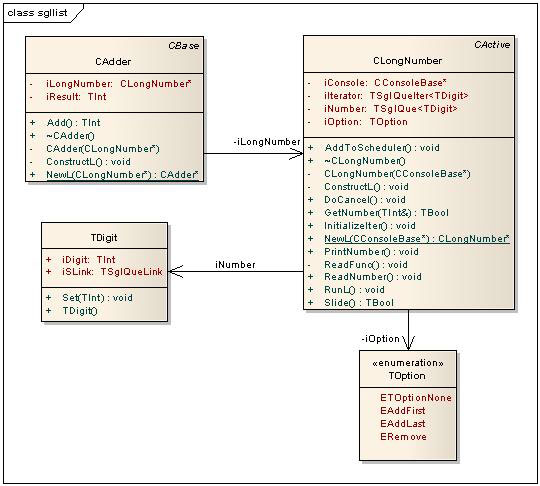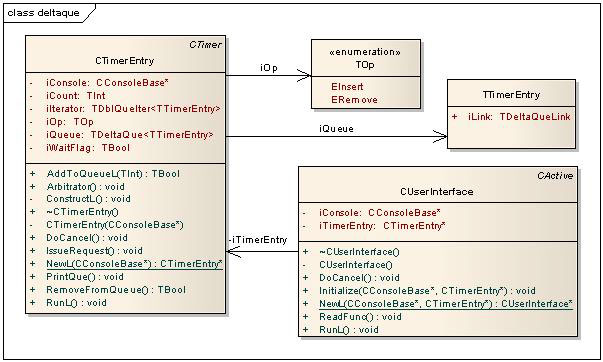linkedlist: Using the Linked List classes
Singly linked list example
This example application demonstrates the use of singly linked lists. The templated TSglQue class is used to create a singly linked list.
Download
Click on the following link to download the example: sgllist.zip
Click: browse to view the example.
Description
The example creates a singly linked list of objects of the TDigit class. This list represents a long number. An object of class CLongNumber owns the list. The user can edit this list using the functions defined in the CLongNumber class. The following edit operations are possible:
Insert an object of the TDigit class at the start of the singly linked list
Insert an object of the TDigit class at the end of the singly linked list
Remove an object of the TDigit class from the end of the singly linked list
The user can perform any of these operations by pressing keys specified in the menu. CLongNumber is an active object class and handles the key press events in the CLongNumber::RunL() function.The CLongNumber::ReadFunc() function displays a menu and waits for an asynchronous key press event.
An object of the templated TSglQueIter class is used to traverse this linked list. The sum of all digits of the number represented by the linked list is displayed to the user.
An object of the CAdder class is used to traverse the CLongNumber::iNumber list and print the sum of all digits of the number represented by this list. The CAdder::Add() function gets this sum.
Related APIs
Design and implementation
Figure 1 shows the classes in the example.
Class summary
Build
For the emulator, the example builds an executable called sgllist.exe in the epoc32\release\winscw\<udeb or urel>\ folder.
See also:
Doubly linked list example
This example application demonstrates the use of doubly linked lists. The templated TDblQue class is used create a doubly linked list.
Download
Click on the following link to download the example: dbllist.zip
Click: browse to view the example code
Description
The example creates a doubly linked list of objects of the TLetter class. This list represents a character string. An object of class CMyStringReverse owns this string. The user can edit this string using the functions defined in the CMyStringReverse class. The following edit operations are possible:
The user can perform either of these operations by pressing keys specified in the menu. CMyStringReverse is an active object class and handles key press events in the CMyStringReverse::RunL() function. The CMyStringReverse::ReadFunc() function displays a menu and waits for an asynchronous key press event.
The CMyStringReverse class has a doubly linked list iterator, iIteratorString. The iIteratorString object iterates through the list iString from start to end to print the string reversed.
Design and implementation
Figure 2 shows the classes in the example.
Class summary
TDblQue - A templated class that provides the behaviour for managing a doubly linked list.
Build
For the emulator, the example builds an executable called dbllist.exe in the epoc32\release\winscw\<udeb or urel>\ folder.
See also
Example code
Delta queue example
This example application demonstrates the use of the delta queue. The templated TDeltaQue class is used create a delta queue.
Download
Click on the following link to download the example: deltaque.zip
Click: browse to view the example code.
Description
The example creates an object of the CTimerEntry class. This is a CTimer derived class. An object of this class generates timer events by using the CTimer::After() function. The data member of this class, iQueue is a delta list. The offset value of each node in this list is the tick count after each timer event. The CTimerEntry::Arbitrator() function decides the action to be performed for each event generated by the timer. It either adds tick counts to the list or removes elements from the list based on the state of the queue.
Related APIs
CTimer - Base class for a timer active object.
Design and implementation
Figure 3 shows the classes of the example.
Class summary
Build
For the emulator, the example builds an executable called deltaque.exe in the epoc32\release\winscw\<udeb or urel>\ folder.
Copyright ©2010 Nokia Corporation and/or its subsidiary(-ies).
All rights
reserved. Unless otherwise stated, these materials are provided under the terms of the Eclipse Public License
v1.0.


